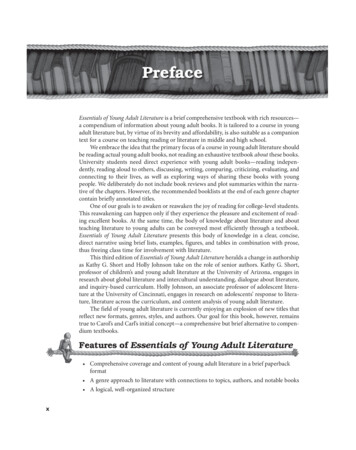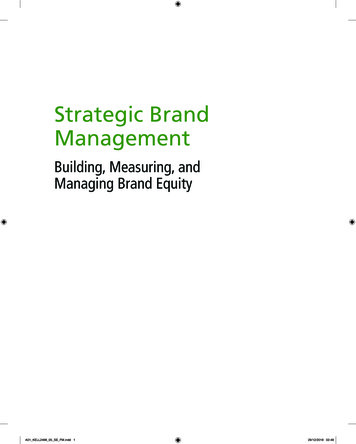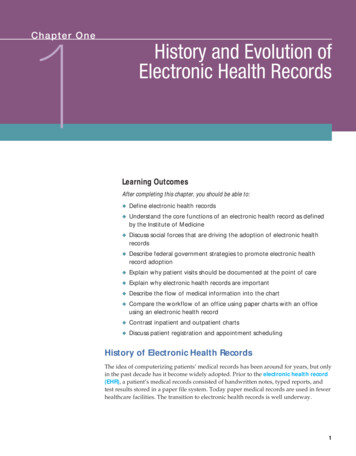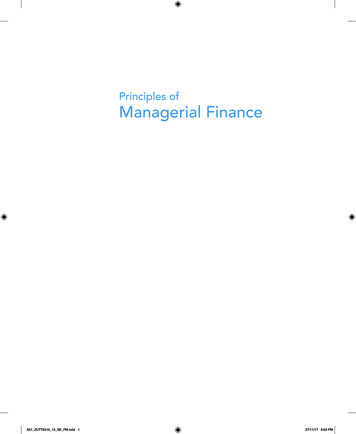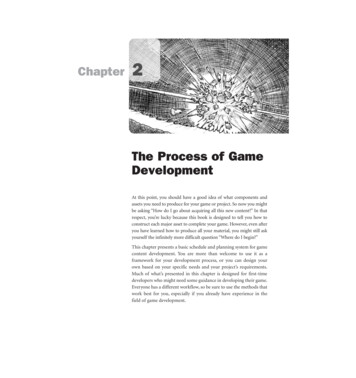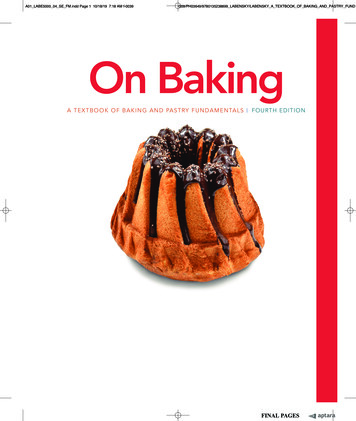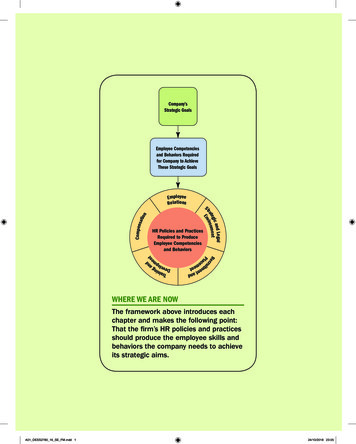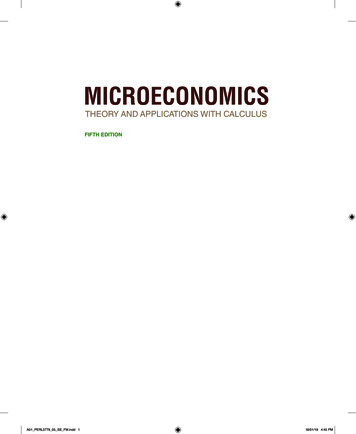
Transcription
MICROECONOMICSTHEORY AND APPLICATIONS WITH CALCULUSFIFTH EDITIONA01 PERL3779 05 SE FM.indd 118/01/19 4:45 PM
A01 PERL3779 05 SE FM.indd 218/01/19 4:45 PM
MICROECONOMICSTHEORY AND APPLICATIONS WITH CALCULUSFIFTH EDITIONJEFFREY M. PERLOFFUniversity of California, BerkeleyA01 PERL3779 05 SE FM.indd 318/01/19 4:46 PM
FOR LISAVice President, Business, Economics, and UK Courseware:Donna BattistaDirector of Portfolio Management: Adrienne D’AmbrosioSpecialist Portfolio Manager: Christopher DeJohnEditorial Assistant: Aly GrindallVice President, Product Marketing: Roxanne McCarleySenior Product Marketer: Carlie MarvelProduct Marketing Assistant: Marianela SilvestriManager of Field Marketing, Business Publishing: AdamGoldsteinField Marketing Manager: Ashley BryanVice President, Production and Digital Studio, Arts andBusiness: Etain O’DeaDirector, Production and Digital Studio, Business andEconomics: Ashley SantoraManaging Producer, Business: Alison KalilContent Producer: Carolyn PhilipsOperations Specialist: Carol MelvilleDesign Lead: Kathryn FootManager, Learning Tools: Brian SuretteSenior Learning Tools Strategist: Emily BibergerManaging Producer, Digital Studio and GLP: James BatemanManaging Producer, Digital Studio: Diane LombardoDigital Studio Producer: Melissa HonigDigital Studio Producer: Alana ColesDigital Content Team Lead: Noel LotzDigital Content Project Lead: Courtney KamaoufFull Service Project Management: Pearson CSC, NicoleSuddeth and Kathy SmithInterior Design: Pearson CSCCover Design: Pearson CSCCover Art: Simon Gribkov/EyeEm, GettyImagesPrinter/Binder: LSC Communications, Inc./WillardCover Printer: Phoenix Color/HagerstownMicrosoft and/or its respective suppliers make no representations about the suitability of the information contained in the documentsand related graphics published as part of the services for any purpose. All such documents and related graphics are provided “as is”without warranty of any kind. Microsoft and/or its respective suppliers hereby disclaim all warranties and conditions with regard tothis information, including all warranties and conditions of merchantability, whether express, implied or statutory, fitness for a particular purpose, title and non-infringement. In no event shall Microsoft and/or its respective suppliers be liable for any special, indirector consequential damages or any damages whatsoever resulting from loss of use, data or profits, whether in an action of contract, negligence or other tortious action, arising out of or in connection with the use or performance of information available from the services.The documents and related graphics contained herein could include technical inaccuracies or typographical errors. Changes areperiodically added to the information herein. Microsoft and/or its respective suppliers may make improvements and/or changes in theproduct(s) and/or the program(s) described herein at any time. Partial screen shots may be viewed in full within the software versionspecified.Microsoft and Windows are registered trademarks of the Microsoft Corporation in the U.S.A. and other countries. This book is notsponsored or endorsed by or affiliated with the Microsoft Corporation.Copyright 2020, 2017, 2014 by Pearson Education, Inc. or its affiliates. All Rights Reserved. Manufactured in the United States ofAmerica. This publication is protected by copyright, and permission should be obtained from the publisher prior to any prohibitedreproduction, storage in a retrieval system, or transmission in any form or by any means, electronic, mechanical, photocopying, recording, or otherwise. For information regarding permissions, request forms, and the appropriate contacts within the Pearson EducationGlobal Rights and Permissions department, please visit www.pearsoned.com/permissions/.Acknowledgments of third-party content appear on page E-109, which constitutes an extension of this copyright page.PEARSON, ALWAYS LEARNING, and MYLAB are exclusive trademarks owned by Pearson Education, Inc. or its affiliates in the U.S.and/or other countries.Unless otherwise indicated herein, any third-party trademarks, logos, or icons that may appear in this work are the property of theirrespective owners, and any references to third-party trademarks, logos, icons, or other trade dress are for demonstrative or descriptive purposes only. Such references are not intended to imply any sponsorship, endorsement, authorization, or promotion of Pearson’sproducts by the owners of such marks, or any relationship between the owner and Pearson Education, Inc., or its affiliates, authors,licensees, or distributors.Cataloging-in-Publication Data is available on file at the Library of Congress219ISBN 10: 0-13-518377-4ISBN 13: 978-0-13-518377-9A01 PERL3779 05 SE FM.indd 418/01/19 4:46 PM
Brief ContentsPrefacexivChapter 1IntroductionChapter 2Supply and Demand10Chapter 3A Consumer’s Constrained Choice62Chapter 4Demand105Chapter 5Consumer Welfare and Policy Analysis142Chapter 6Firms and Production177Chapter 7Costs209Chapter 8Competitive Firms and Markets248Chapter 9Properties and Applications of the Competitive Model290Chapter 10General Equilibrium and Economic Welfare327Chapter 11Monopoly and Monopsony365Chapter 12Pricing and Advertising412Chapter 13Game Theory452Chapter 14Oligopoly and Monopolistic Competition490Chapter 15Factor Markets539Chapter 16Uncertainty574Chapter 17Property Rights, Externalities, Rivalry, and Exclusion610Chapter 18Asymmetric Information645Chapter 19Contracts and Moral Hazards672Calculus Appendix1E-1Regression AppendixE-29Answers to Selected ExercisesE-32DefinitionsE-53ReferencesE-59Sources for Applications and ChallengesE-68IndexE-77CreditsE-109vA01 PERL3779 05 SE FM.indd 518/01/19 4:46 PM
ContentsPrefaceChapter 1 Introduction1.1 Microeconomics: The Allocation ofScarce ResourcesTrade-OffsWho Makes the DecisionsHow Prices Determine AllocationsAPPLICATION Twinkie Tax1.2 ModelsAPPLICATION Income Threshold Modeland ChinaSimplifications by AssumptionTesting TheoriesMaximizing Subject to ConstraintsPositive Versus NormativeNew Theories1.3 Uses of Microeconomic Models in YourLife and CareerSummary 9Chapter 2 Supply and DemandCHALLENGE Quantities and Prices2.12.22.32.4of Genetically Modified FoodsDemandThe Demand FunctionSumming Demand FunctionsAPPLICATION Aggregating CornDemand CurvesSupplyThe Supply FunctionSumming Supply FunctionsHow Government Import PoliciesAffect Supply CurvesMarket EquilibriumFinding the Market EquilibriumForces That Drive a Market to EquilibriumShocking the Equilibrium: ComparativeStaticsComparative Statics with Discrete (Large)ChangesAPPLICATION The Opioid Epidemic’sLabor Market EffectsComparative Statics with Small ChangesSolved Problem 2.1viWhy the Shapes of Demand and SupplyCurves MatterA01 PERL3779 05 SE FM.indd 6xiv2.5 ElasticitiesDemand Elasticity1Solved Problem 2.2APPLICATION The Demand Elasticities122233Solved Problem 2.3for Google Play and Apple upply ElasticitySolved Problem 2.4Long Run Versus Short RunAPPLICATION Oil Drilling in the ArcticNational Wildlife RefugeSolved Problem 2.52.6 Effects of a Sales TaxEffects of a Specific Tax on the EquilibriumThe Same Equilibrium No Matter WhoIs TaxedFirms and Customers Share the Burdenof the TaxSolved Problem 2.6APPLICATION Subsidizing EthanolThe Similar Effects of Ad Valorem andSpecific Taxes2.7 Quantity Supplied Need Not Equal QuantityDemandedPrice CeilingAPPLICATION Venezuelan Price Ceilingsand ShortagesPrice Floor2.8 When to Use the Supply-and-DemandModelCHALLENGE SOLUTION Quantities andPrices of Genetically Modified FoodsSummary 55 7 Exercises apter 3 A Consumer’s ConstrainedChoiceCHALLENGE Why Americans BuyE-Books and Germans Do Not3.1 PreferencesProperties of Consumer PreferencesAPPLICATION You Can’t Have TooMuch MoneyPreference MapsIndifference CurvesSolved Problem 3.13.2 UtilityUtility FunctionWillingness to Substitute Between Goods626264646566676969697218/01/19 4:46 PM
ContentsSolved Problem 3.2APPLICATION MRS Between RecordedTracks and Live MusicCurvature of Indifference CurvesSolved Problem 3.3APPLICATION Indifference Curves BetweenFood and Clothing3.3 Budget Constraint3.4 Constrained Consumer ChoiceFinding an Interior Solution Using GraphsSolved Problem 3.4Finding an Interior Solution Using CalculusSolved Problem 3.5Solved Problem 3.6Solved Problem 3.7APPLICATION Utility Maximization forRecorded Tracks and Live MusicFinding Corner SolutionsMinimizing ExpenditureSolved Problem 3.83.5 Behavioral EconomicsTests of TransitivityEndowment EffectAPPLICATION How You Ask a QuestionMattersSalienceCHALLENGE SOLUTION Why AmericansBuy E-Books and Germans Do NotSummary 100 7 Exercises 101Chapter 4 DemandCHALLENGE Paying Employees toRelocate4.1 Deriving Demand CurvesSystem of Demand FunctionsGraphical InterpretationAPPLICATION Cigarettes Versus E-Cigarettes4.2 Effects of an Increase in IncomeHow Income Changes Shift Demand CurvesSolved Problem 4.1Consumer Theory and Income ElasticitiesSolved Problem 4.2APPLICATION Fast-Food Engel CurveSolved Problem 4.34.3 Effects of a Price IncreaseIncome and Substitution Effects with aNormal GoodSolved Problem 4.4APPLICATION Substituting Marijuanafor AlcoholSolved Problem 4.5Income and Substitution Effects withan Inferior GoodSolved Problem 4.6Compensated Demand CurveA01 PERL3779 05 SE FM.indd 22123123124Solved Problem 4.7Slutsky Equation4.4 Cost-of-Living AdjustmentInflation IndexesEffects of Inflation AdjustmentsAPPLICATION Reducing the CPISubstitution Bias4.5 Revealed PreferenceRecovering PreferencesSubstitution EffectCHALLENGE SOLUTION Paying Employeesto RelocateSummary 138 7 Exercises 139vii127127129129131134135135136137Chapter 5 Consumer Welfare andPolicy AnalysisCHALLENGE Per-Hour Versus Lump-SumChildcare Subsidies5.1 Uncompensated Consumer WelfareWillingness to PayAn Individual’s Consumer SurplusA Market’s Consumer SurplusAPPLICATION Willingness to Pay andConsumer Surplus on eBayEffect of a Price Change on Consumer SurplusSolved Problem 5.15.2 Compensated Consumer WelfareIndifference Curve AnalysisAPPLICATION Compensating Variationand Equivalent Variation forSmartphones and FacebookCompensated Demand Curves andConsumer WelfareComparing the Three Welfare MeasuresSolved Problem 5.25.3 Effects of Government Policies onConsumer WelfareQuotasFood StampsAPPLICATION Food Stamps Versus Cash5.4 Deriving Labor Supply CurvesLabor-Leisure ChoiceSolved Problem 5.3Income and Substitution EffectsSolved Problem 5.4APPLICATION Fracking Causes Studentsto Drop OutSolved Problem 5.5Shape of the Labor Supply CurveIncome Tax Rates and the LaborSupply CurveSolved Problem 5.6CHALLENGE SOLUTION Per-Hour VersusLump-Sum Childcare SubsidiesSummary 172 7 Exercises 9 4:46 PM
viiiContents Chapter 6 Firms and ProductionCHALLENGE Labor ProductivityDuring Downturns6.1 The Ownership and Management of FirmsPrivate, Public, and Nonprofit FirmsAPPLICATION Chinese State-OwnedEnterprisesThe Ownership of For-Profit FirmsThe Management of FirmsWhat Owners Want6.2 ProductionProduction FunctionsTime and the Variability of Inputs6.3 Short-Run Production: One Variableand One Fixed InputSolved Problem 6.1Interpretation of GraphsSolved Problem 6.2Law of Diminishing Marginal ReturnsAPPLICATION Malthus and the GreenRevolution6.4 Long-Run Production: Two Variable InputsIsoquantsAPPLICATION Self-Driving TrucksSubstituting InputsSolved Problem 6.3Diminishing Marginal Rates ofTechnical SubstitutionThe Elasticity of SubstitutionSolved Problem 6.46.5 Returns to ScaleConstant, Increasing, and DecreasingReturns to ScaleSolved Problem 6.5APPLICATION Returns to Scale in VariousIndustriesVarying Returns to Scale6.6 Productivity and Technical ChangeRelative ProductivityInnovationsAPPLICATION Robots and the Food You EatAPPLICATION A Good Boss RaisesProductivityCHALLENGE SOLUTION LaborProductivity During DownturnsSummary 205 7 Exercises 206Chapter 7 CostsCHALLENGE Technology Choice atHome Versus Abroad7.1 Measuring CostsOpportunity CostsAPPLICATION The Opportunity Cost ofan MBAA01 PERL3779 05 SE FM.indd 203204204209209210211Solved Problem 7.1Opportunity Cost of CapitalSunk Costs7.2 Short-Run CostsShort-Run Cost MeasuresAPPLICATION The Sharing Economyand the Short RunSolved Problem 7.2Short-Run Cost CurvesProduction Functions and the Shape ofCost CurvesAPPLICATION Short-Run Cost Curvesfor a Japanese Beer ManufacturerEffects of Taxes on CostsShort-Run Cost Summary7.3 Long-Run CostsInput ChoiceSolved Problem 7.3Solved Problem 7.4How Long-Run Cost Varies with OutputSolved Problem 7.5Solved Problem 7.6The Shape of Long-Run Cost CurvesAPPLICATION 3D PrintingEstimating Cost Curves VersusIntrospection7.4 Lower Costs in the Long RunLong-Run Average Cost as the Envelopeof Short-Run Average Cost CurvesAPPLICATION A Beer Manufacturer’sLong-Run Cost CurvesAPPLICATION Choosing an Inkjet orLaser PrinterShort-Run and Long-Run Expansion PathsHow Learning by Doing Lowers CostsAPPLICATION Solar Power LearningCurves7.5 Cost of Producing Multiple GoodsCHALLENGE SOLUTION TechnologyChoice at Home Versus AbroadSummary 243 7 Exercises 244Chapter 8 Competitive Firms and MarketsCHALLENGE The Rising Cost of KeepingOn Truckin’8.1 Perfect CompetitionPrice TakingWhy a Firm’s Demand Curve Is HorizontalPerfect Competition in the ChicagoCommodity ExchangeDeviations from Perfect CompetitionDerivation of a Competitive Firm’sDemand CurveSolved Problem 8.1211Why Perfect Competition Is 4224824824924925025125125225425418/01/19 4:46 PM
Content
MICROECONOMICS THEORY AND APPLICATIONS WITH CALCULUS FIFTH EDITION A01_PERL3779_05_SE_FM.indd 1 18/01/19 4:45 PM. A01_PERL3779_05_SE_FM.indd 2 18/01/19 4:45 PM. MICROECONOMICS THEORY AND APPLICATIONS WITH CALCULUS FIFTH EDITION JEFFREY M. PERLOFF University of California, Berkeley A01_PERL3779_05_SE_FM.indd 3 18/01/19 4:46 PM.
